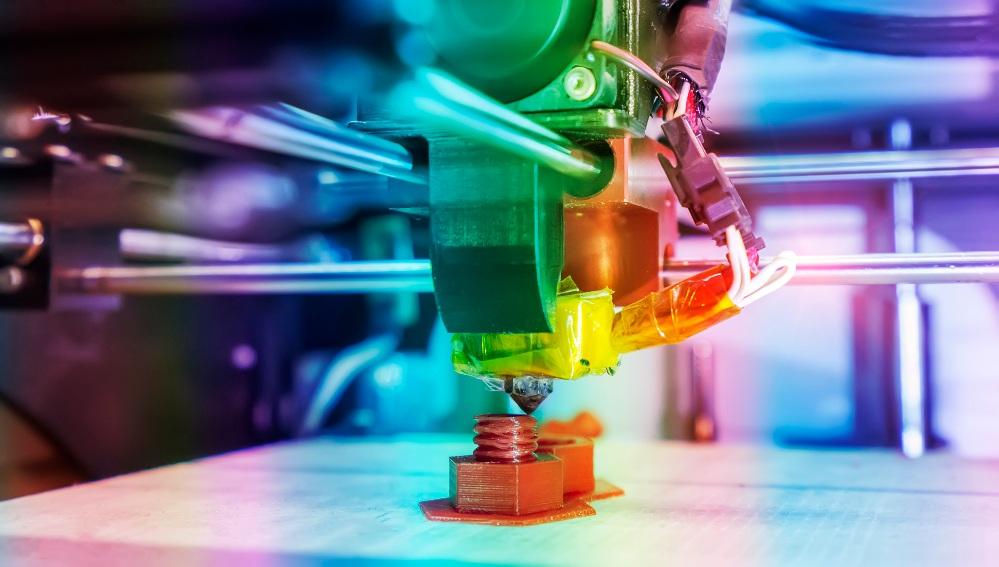- FMA
- The Fabricator
- FABTECH
- Canadian Metalworking
Our Publications
Categories
- Additive Manufacturing
- Aluminum Welding
- Arc Welding
- Assembly and Joining
- Automation and Robotics
- Bending and Forming
- Consumables
- Cutting and Weld Prep
- Electric Vehicles
- En Español
- Finishing
- Hydroforming
- Laser Cutting
- Laser Welding
- Machining
- Manufacturing Software
- Materials Handling
- Metals/Materials
- Oxyfuel Cutting
- Plasma Cutting
- Power Tools
- Punching and Other Holemaking
- Roll Forming
- Safety
- Sawing
- Shearing
- Shop Management
- Testing and Measuring
- Tube and Pipe Fabrication
- Tube and Pipe Production
- Waterjet Cutting
Industry Directory
Webcasts
Podcasts
FAB 40
Advertise
Subscribe
Account Login
Search
Changing colors: the next big thing in additive manufacturing
Nano-inks for 3D printers change color when subjected to mechanical forces
- By Kip Hanson
- July 28, 2022
Forget black, white, and clear SLA resins. Move over hot-pink PLA and fluorescent-orange ABS filaments. Here come color-shifting colloidal nano-inks.
There’s a scientific paper floating around the internet that could have a significant effect on the 3D printing industry. Its author is Jong Bin Kim, who, along with a team of researchers in the Republic of Korea, are experimenting with direct writing of colloidal inks.
In a nutshell, they’ve found a way to disperse silica particles in acrylate-based resins, then print these inks onto various substrates. The resulting graphics boast a high degree of mechanical stability, brightness, and color saturation—and they can be folded or stretched with impunity.
The main takeaway is this: Colloidal inks can be made to change color when subjected to mechanical forces. Taken to the logical conclusion, this means 3D-printed basketball shoes could turn fluorescent green after a game-winning jump shot. It means equipment handles, knobs, and brackets that could turn red when the proper torque is achieved, and dental aligners that give their wearers an iridescent smile.
What’s more, colloidal nanoparticles are known to react to electrical, thermal, and chemical stimuli. They’re also tunable. We could one day be 3D-printing objects that adjust their shape when subjected to certain chemicals or inhibit electrical activity at a given temperature. Yes, some of these same applications are possible using traditional manufacturing techniques—but without 3D printing’s immense flexibility.
Basketball shoes 3D-printed with colloidal inks could turn bright fluorescent green after a game-winning jump shot.
Come to think of it, I wrote a similar Additive Report blog roughly one year ago that discussed 4D printing and its use of “programmable” materials.
Time and again, the promise of 3D printing revolves not so much around the complex geometries and freeform shapes it enables, but, rather, the polymers and metals. And seeing that most additive materials on the market today were developed for the plastic injection molding and powder-metal industries—not 3D printing—there’s likely some truly mind-blowing stuff coming our way.
Remember, the 3D printing industry was launched 30-plus years ago using resins designed for tabletop veneers. Imagine what future inventors will develop with colloidal inks.
About the Author

Kip Hanson
About the Publication
- Podcasting
- Podcast:
- The Fabricator Podcast
- Published:
- 04/16/2024
- Running Time:
- 63:29
In this episode of The Fabricator Podcast, Caleb Chamberlain, co-founder and CEO of OSH Cut, discusses his company’s...
- Trending Articles
- Industry Events
16th Annual Safety Conference
- April 30 - May 1, 2024
- Elgin,
Pipe and Tube Conference
- May 21 - 22, 2024
- Omaha, NE
World-Class Roll Forming Workshop
- June 5 - 6, 2024
- Louisville, KY
Advanced Laser Application Workshop
- June 25 - 27, 2024
- Novi, MI




























